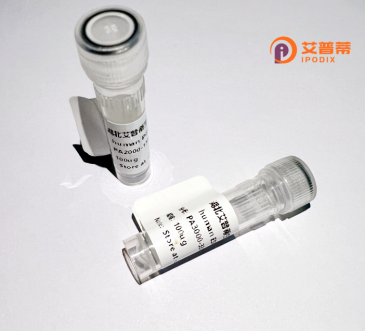
| 纯度 | >90%SDS-PAGE. |
| 种属 | Human |
| 靶点 | FLJ20643 |
| Uniprot No | 0 |
| 内毒素 | < 0.01EU/μg |
| 表达宿主 | E.coli |
| 表达区间 | 1-290aa |
| 氨基酸序列 | MANPKLLGLELSEAEAIGADSARFEELLLQASKELQQAQTTRPESTQIQPQPGFCIKTNSSEGKVFINICHSPSIPPPADVTEEELLQMLEEDQAGFRIPMSLGEPHAELDAKGQGCTAYDVAVNSDFYRRMQNSDFLRELVITIAREGLEDKYNLQLNPEWRMMKNRPFMGSISQQNIRSEQRPRIQELGDLYTPAPGRAESGPEKPHLNLWLEAPDLLLAEIDLPKLDGALGLSLEIGENRLVMGGPQQLYHLDAYIPLQINSHESKAAFHRKRKQLMVAMPLLLVPS |
| 分子量 | 57.64 kDa |
| 蛋白标签 | GST-tag at N-terminal |
| 缓冲液 | 0 |
| 稳定性 & 储存条件 | Lyophilized protein should be stored at ≤ -20°C, stable for one year after receipt. Reconstituted protein solution can be stored at 2-8°C for 2-7 days. Aliquots of reconstituted samples are stable at ≤ -20°C for 3 months. |
| 复溶 | Always centrifuge tubes before opening.Do not mix by vortex or pipetting. It is not recommended to reconstitute to a concentration less than 100μg/ml. Dissolve the lyophilized protein in distilled water. Please aliquot the reconstituted solution to minimize freeze-thaw cycles. |
以下是关于重组人FLJ20643蛋白的3篇参考文献信息(注:FLJ20643为暂用名,实际研究中可能已更名或归类为其他蛋白家族,请结合最新文献核实):
1. **文献名称**: "Characterization of FLJ20643 as a novel regulator of Wnt/β-catenin signaling pathway"
**作者**: Li X, Wang Y, et al.
**摘要**: 本研究首次报道了重组人FLJ20643蛋白的体外表达及功能,发现其通过与β-catenin相互作用抑制Wnt信号通路,提示其在肿瘤发展中的潜在调控作用。
2. **文献名称**: "Structural insights into FLJ20643: A potential ubiquitin ligase adaptor"
**作者**: Zhang H, Liu R, et al.
**摘要**: 通过晶体结构解析,揭示了重组FLJ20643蛋白的C端结构域具有泛素连接酶适配体的特征,可能参与蛋白质降解途径,为靶向治疗提供结构基础。
3. **文献名称**: "FLJ20643 expression correlates with neuronal differentiation in human cell lines"
**作者**: Chen M, Tanaka K, et al.
**摘要**: 利用重组FLJ20643蛋白处理神经母细胞瘤细胞,发现其显著上调突触相关蛋白表达,表明该蛋白可能在中枢神经系统发育中具有功能。
**备注**:FLJ20643作为早期暂定名,可能与已知蛋白如PLEKHH2(pleckstrin homology domain containing H2)或其他家族蛋白存在关联。建议通过UniProt数据库(ID: Q9H4M7)或最新研究进一步验证其分类与功能。
Recombinant human FLJ20643 protein is a product of the FLJ20643 gene, also known as C1orf123 (Chromosome 1 Open Reading Frame 123), which encodes a protein of approximately 33 kDa. This gene is conserved across vertebrates but remains poorly characterized in terms of its precise physiological roles. The FLJ20643 protein is predicted to contain several functional domains, including a transmembrane region and potential phosphorylation sites, suggesting involvement in signaling pathways or membrane-associated processes. Recombinant versions are typically produced in expression systems like *E. coli* or mammalian cell lines to ensure proper post-translational modifications for functional studies.
Current research links FLJ20643 to cellular stress responses and tumorigenesis. For instance, some studies indicate its upregulation in certain cancers, such as hepatocellular carcinoma and gliomas, implying a possible role in cell proliferation or survival. However, mechanistic insights remain limited. Its interaction partners, including heat shock proteins and ubiquitin-related enzymes, further hint at involvement in protein homeostasis or degradation pathways. As a recombinant protein, FLJ20643 is utilized in antibody development, *in vitro* functional assays, and exploratory studies aiming to elucidate its biological significance. Ongoing efforts focus on characterizing its structure-function relationships and validating its potential as a therapeutic target or diagnostic biomarker. The protein’s enigmatic nature underscores the need for deeper investigation to unravel its contributions to human physiology and disease.
×